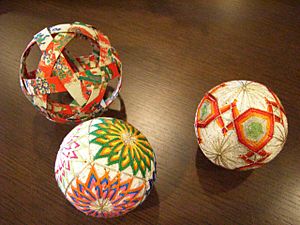Temari (toy) facts for kids
Temari (pronounced teh-MAH-ree) are special balls from Japan. They are a type of folk art and Japanese craft. This means they are handmade and show off traditional skills. These colorful balls first came from China to Japan around the 7th century A.D. The word "Temari" means "hand ball" in Japanese.
Temari balls are made using embroidery techniques. People can use them for games like handball or hacky sack. Sometimes, a similar item is made with a hand-strap and a tassel. This can be used as a fancy accessory for a kimono, which is a traditional Japanese robe. It's like a small, decorative kimono bag.
The Tradition of Temari Gifts
Temari balls are very special gifts in Japan. Giving a Temari shows deep friendship and loyalty to someone. The bright colors and threads used on the balls also have a special meaning. They are a wish for the person to have a brilliant and happy life.
Becoming a Temari artist in Japan is a serious process. It needs special training. Artists must pass tests to show their skills before they are recognized as true Temari crafters.
In the past, parents often gave Temari to their children on New Year's Day. Inside the tightly wrapped layers of each ball, mothers would hide a small piece of paper. On this paper was a secret wish for their child. The child would never know what wish their mother had made while creating the ball.
Some Temari balls also had "noisemakers" inside them. These could be rice grains or tiny bells. They added extra fun when playing with the ball. It is said that old traditional Temari were wrapped so tightly they could actually bounce! Temari are also sometimes called "gotenmari."
How Temari Balls Are Made
Making a Temari ball follows a specific method. First, the ball is divided into sections. This is done by placing temporary pins and then adding permanent threads. There are three main ways to divide a Temari ball. These are called simple division (tanjun toubun), 8-combination division (hachitoubun no kumiawase), and 10-combination division (juutoubun no kumiawase). These divisions help guide the beautiful embroidery patterns.
See also
 In Spanish: Temari (juguete) para niños
In Spanish: Temari (juguete) para niños



